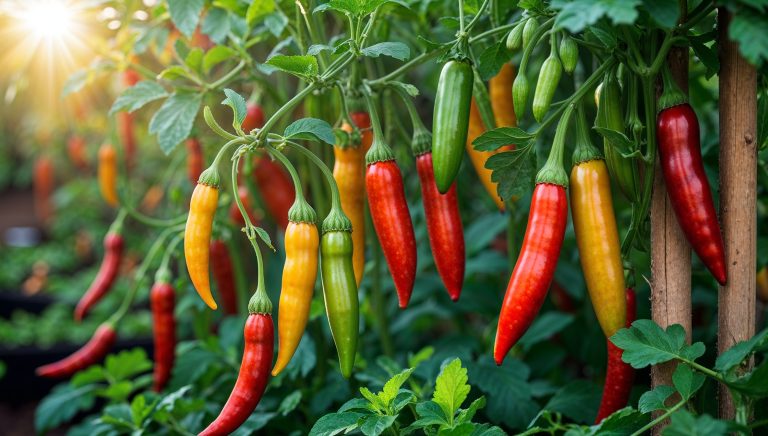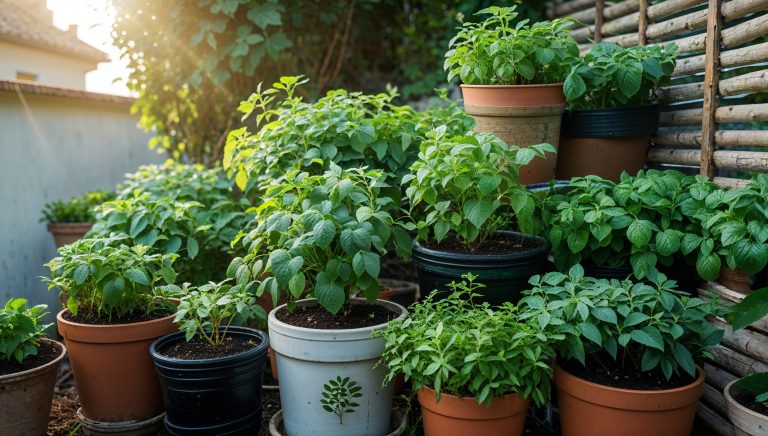Herbs are a fantastic addition to any garden, offering fresh, flavorful ingredients for cooking and natural remedies. Growing herbs in containers is an excellent option for those with limited garden space, such as apartment dwellers or people with small patios or balconies. With the right container, soil, and care, you can grow a wide variety of herbs in pots, making them easy to access and move around. In this article, we’ll guide you through the process of growing and caring for herbs in containers, so you can enjoy fresh herbs right at your fingertips.
1. Choosing the Right Containers for Herbs
Selecting the right container is essential for growing healthy herbs. While many herbs can be grown in a variety of pots, certain factors should be considered to ensure they thrive:
- Size of the Container: Choose a container that is large enough to accommodate the roots of your herbs but not too large that the soil stays too wet. For most herbs, a pot that is at least 6-8 inches deep and wide is ideal. Larger herbs like rosemary or oregano will need larger pots to allow their roots to spread.
- Drainage: Proper drainage is crucial to prevent water from accumulating at the bottom of the pot, which can lead to root rot. Ensure that your container has drainage holes at the bottom. If you’re using a decorative pot without holes, consider placing the plant in a plastic pot with drainage and then setting it inside the decorative one.
- Material of the Pot: Containers come in a variety of materials, including plastic, clay, ceramic, and wood. Each has its benefits:
- Plastic pots are lightweight and retain moisture well.
- Clay pots are breathable and allow the soil to dry out more quickly.
- Ceramic pots are aesthetically pleasing and come in various designs.
- Wooden planters provide a rustic look and are a great option for growing larger herbs like mint and basil.
- Mobility: If you plan to move your containers around to find the best sunlight, choose lightweight pots or ones with wheels for easy mobility.
2. Selecting the Right Soil for Container Herbs
The soil you use in your containers is just as important as the container itself. Herbs require well-draining, fertile soil to thrive in pots.
- Potting Mix: Use a high-quality potting mix designed for container plants. Avoid using garden soil, as it is too heavy and can lead to poor drainage in containers. A good potting mix should be lightweight and contain ingredients like peat moss, perlite, and vermiculite to ensure proper aeration and moisture retention.
- Soil Amendment: Add organic matter like compost or worm castings to improve the soil’s fertility and provide essential nutrients for your herbs. This will help the plants grow strong and healthy.
- pH Level: Most herbs prefer slightly acidic to neutral soil, with a pH level between 6.0 and 7.0. If you’re unsure of your soil’s pH, you can test it with a simple soil test kit, which will help you make necessary adjustments if needed.
3. Planting Herbs in Containers
Once you’ve chosen the right container and prepared the soil, it’s time to plant your herbs. Here’s how to plant herbs in containers:
- Spacing: When planting multiple herbs in one container, make sure to space them appropriately. Most herbs need room to grow and spread, so give them enough space to develop a strong root system. If planting different herbs together, choose varieties with similar water and sunlight needs.
- Planting Depth: For each herb, make sure to plant them at the same depth they were growing in their nursery pots. Don’t plant them too deep, as this can cause the stems to rot. The top of the root ball should be level with the soil surface.
- Watering After Planting: After planting your herbs, water them thoroughly to settle the soil and eliminate any air pockets around the roots. Ensure that the water drains out of the bottom of the container.
4. Caring for Herbs in Containers
Caring for container-grown herbs requires regular attention, but it’s relatively simple compared to garden planting. Here are some essential care tips:
- Watering: Herbs in containers tend to dry out faster than those in the ground, so they need more frequent watering. Water the herbs when the top inch of soil feels dry to the touch. Ensure that the water drains well from the container and doesn’t sit at the bottom, as this can lead to root rot.
- Sunlight: Most herbs need at least 6-8 hours of direct sunlight per day to thrive. Place your containers in a sunny spot, such as a south-facing balcony, patio, or windowsill. If you don’t have a sunny spot, consider using a grow light to supplement natural sunlight.
- Fertilizing: Herbs are light feeders, but they still benefit from occasional fertilizing. Use an organic liquid fertilizer or compost tea every 4-6 weeks during the growing season to promote healthy growth. Be careful not to over-fertilize, as this can lead to excessive leaf growth and reduced flavor.
- Pruning and Harvesting: Regularly prune and harvest your herbs to encourage new growth and prevent them from becoming leggy. For herbs like basil, mint, and oregano, pinch off the tips of the stems to encourage branching. Harvest leaves regularly to use in cooking or to dry for later use.
- Pest Control: Herbs in containers are less likely to have pest problems than those in the ground, but it’s still important to keep an eye out for common pests like aphids, whiteflies, and spider mites. If you notice pests, gently spray the affected plants with a mixture of water and a small amount of mild soap, or use organic insecticidal soap.
5. Managing Winter Care for Container Herbs
In colder climates, herbs in containers need special care during the winter to protect them from freezing temperatures. Here are some tips for managing your container herbs in the winter months:
- Bring Herbs Indoors: If the temperature drops below freezing, bring your container herbs indoors. Place them in a sunny spot near a window or under grow lights to provide enough light for them to survive through the winter. Make sure they still receive adequate water, but be careful not to overwater them during the colder months.
- Winterizing Outdoor Containers: If you can’t bring your containers indoors, insulate them by wrapping them in burlap or placing them in larger containers with mulch around the outside. Alternatively, you can bury the containers in the ground to protect the roots from frost.
- Reduce Watering: During the winter, herbs typically grow slower and need less water. Reduce the frequency of watering, but ensure the soil remains slightly moist to prevent the roots from drying out completely.
6. Common Herbs to Grow in Containers
Many herbs are well-suited for container growing. Here are some of the most popular herbs that thrive in pots:
- Basil: Perfect for containers, basil thrives in warm, sunny conditions. It’s ideal for growing on a sunny balcony or windowsill.
- Mint: Mint is easy to grow in containers, which helps prevent it from spreading uncontrollably. It thrives in partial to full sunlight.
- Thyme: This hardy herb is perfect for containers and needs a sunny spot with well-drained soil. It’s great for seasoning a variety of dishes.
- Rosemary: Rosemary grows well in containers, especially if you have a sunny spot. It requires a well-drained pot and regular pruning to maintain its shape.
- Chives: Chives are a great herb for containers and can tolerate partial shade. They grow well in small pots and are perfect for adding flavor to salads and soups.
- Parsley: Parsley grows well in containers and prefers cooler temperatures. It’s a great herb to have on hand for garnishes and flavoring dishes.
Conclusion
Growing herbs in containers is a fantastic way to enjoy fresh, homegrown herbs, even if you have limited space. By selecting the right containers, soil, and herbs, and providing the necessary care, you can create a thriving herb garden on your balcony, windowsill, or patio. With regular pruning, watering, and attention, your container herbs will flourish, providing you with a constant supply of flavorful ingredients for your cooking and homemade remedies.

